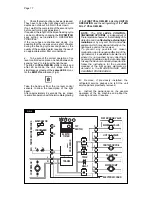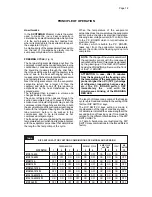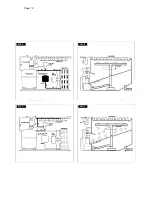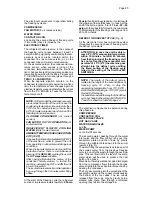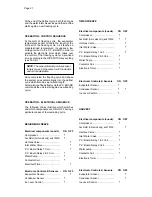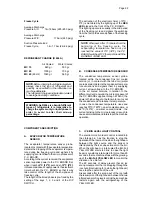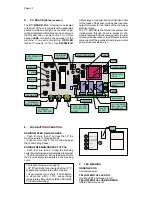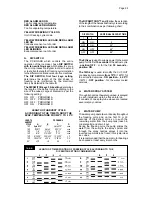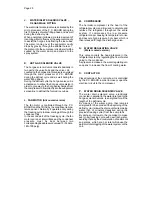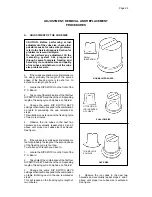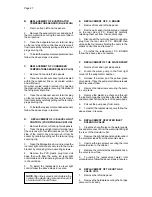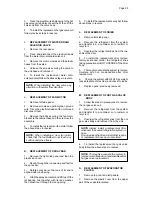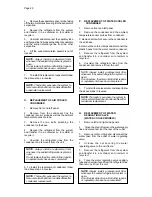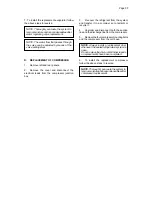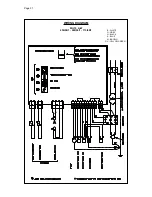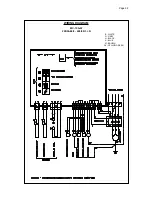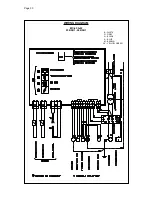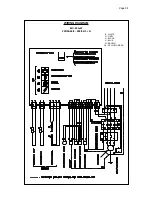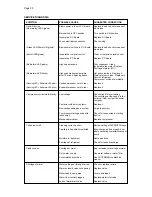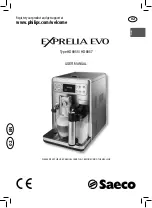
Page 20
Page 20
The electrical components in operation during
the freezing cycle are:
COMPRESSOR
FAN MOTOR (in air cooled version)
WATER PUMP
CONTACTOR COIL
and during the second phase of freezing cycle
(Time mode) they are joined by the
ELECTRONIC TIMER
The refrigerant head pressure, in the course of
the freezing cycle, ranges between 18 and 16
bars (250-225 psig) being controlled by the tem-
perature sensor probe located within the
condenser fins (air cooled version) or, on the
condenser tube coil (water cooled version).
On the air cooled version, the condenser tempe-
rature sensor, when senses a rising of the
condenser temperature beyond the pre-fixed
limit, changes its electrical resistance and send a
low voltage power flow to the Micro Processor of
P.C. BOARD which in turn energizes, through a
TRIAC, the FAN MOTOR.
When the opposite situation occures, i.e. the
condenser temperature gets below the pre-fixed
limit, the temperature sensor changes again its
electrical resistance reducing therefore the current
flow to the P.C. BOARD to cause the fan motor
temporary cut-off.
NOTE. On this model the condenser sensors
are used just to switch off the unit in case the
condensing temperature rise up to more then
70
°
C (for air cooled version) or more then
62
°
C (for water cooled version) for one of the
following abnormal reasons:
CLOGGED CONDENSER (Air cooled
version)
FAN MOTOR OUT OF OPERATION (Air
cooled version)
INSUFFICIENT FLOW OF COOLING
WATER (Water cooled version)
AMBIENT TEMPERATURE HIGHER THEN
40
°
C (100
°
F)
it causes the total and immediate SHUT-OFF
of the machine in order to prevent the unit
from operating in abnormal and dangerous
conditions.
When the ice maker stops on account of this
protective device, there is a simultaneous
glowing of the RED LED, warning the user of
the Hi Temperature situation.
After having efiminated the source of the
condenser hi-temperature, to restart the
machine just switching OFF and ON the unit
at main line switch.
The ice machine resumes its normal operation
by going through the 5 minutes water filling
phase.
At the start of the freezing cycle the refrigerant
suction or lo-pressure lowers rapidly to 2.5 bars-
35 psig then it declines gradually - in relation with
the growing of the ice thickness - to reach, at the
end of the cycle, approx. 1.6
÷
1.7 bar - 22
÷
24
psig with the cubes fully formed in the cup molds.
The total length of the freezing cycle ranges f rom
20 to 25 minutes.
DEFROST OR HARVEST CYCLE (Fig. D)
As the electronic timer has carried the system
throughout the second phase of freezing cycle,
the defrost cycle starts.
ATTENTION. In case the unit be able to
reach 0
°
C (32
°
F) evaporating temperature
within 15 minutes, but after 45 minutes
from the beginning of the freezing cycle it
has not yet reached the evaporator tem-
perature of -15
°
C (5
°
F) the machine goes
straight into the defrost cycle omitting
the timed portion of the freezing cycle
relied to the setting of the first four DIP
SWITCHES.
NOTE. The length of the defrost cycle is
related to the length of the second phase of
freezing cycle T2. (Time to drop the
evaporating temperature from 0
°
C (32
°
F) -
small Red LED blinking-to-15
°
C (5
°
F) small
Red LED ON steady.
It is possible to extend the length of the defrost
cycle by changing the setting of DIP SWITCH
7 and 8 as shown on table at page 24.
The electrical components in operation during
this phase are:
COMPRESSOR
CONTACTOR COIL
WATER INLET VALVE
HOT GAS VALVE
WATER DRAIN VALVE
and the
WATER PUMP
on the first 30 seconds.
The incoming water, passing through the water
inlet valve and the flow control, runs over the
evaporator platen and then flows by gravity
through the dribbler holes down into the sump/
reservoir (Fig. D).
The water filling the sump/reservoir forces part of
the surplus water from the previous freezing
cycle to go out to the waste through the overflow
pipe. This overflow limits the level of the sump
water which will be used to produce the next
batch of ice cubes.
Meanwhile, the refrigerant as hot gas, discharged
from the compressor, flows through the hot gas
valve directly into the evaporator serpentine by-
passing the condenser.
The hot gas circulating into the serpentine of the
evaporator warms up the copper molds causing
the defrost of the ice cubes. The ice cubes,
released from the cups, drop by gravity onto a
slanted cube chute, then through a curtained
opening they fall into the storage bin.
Summary of Contents for MC 15
Page 19: ...Page 19 Page 19 ...












